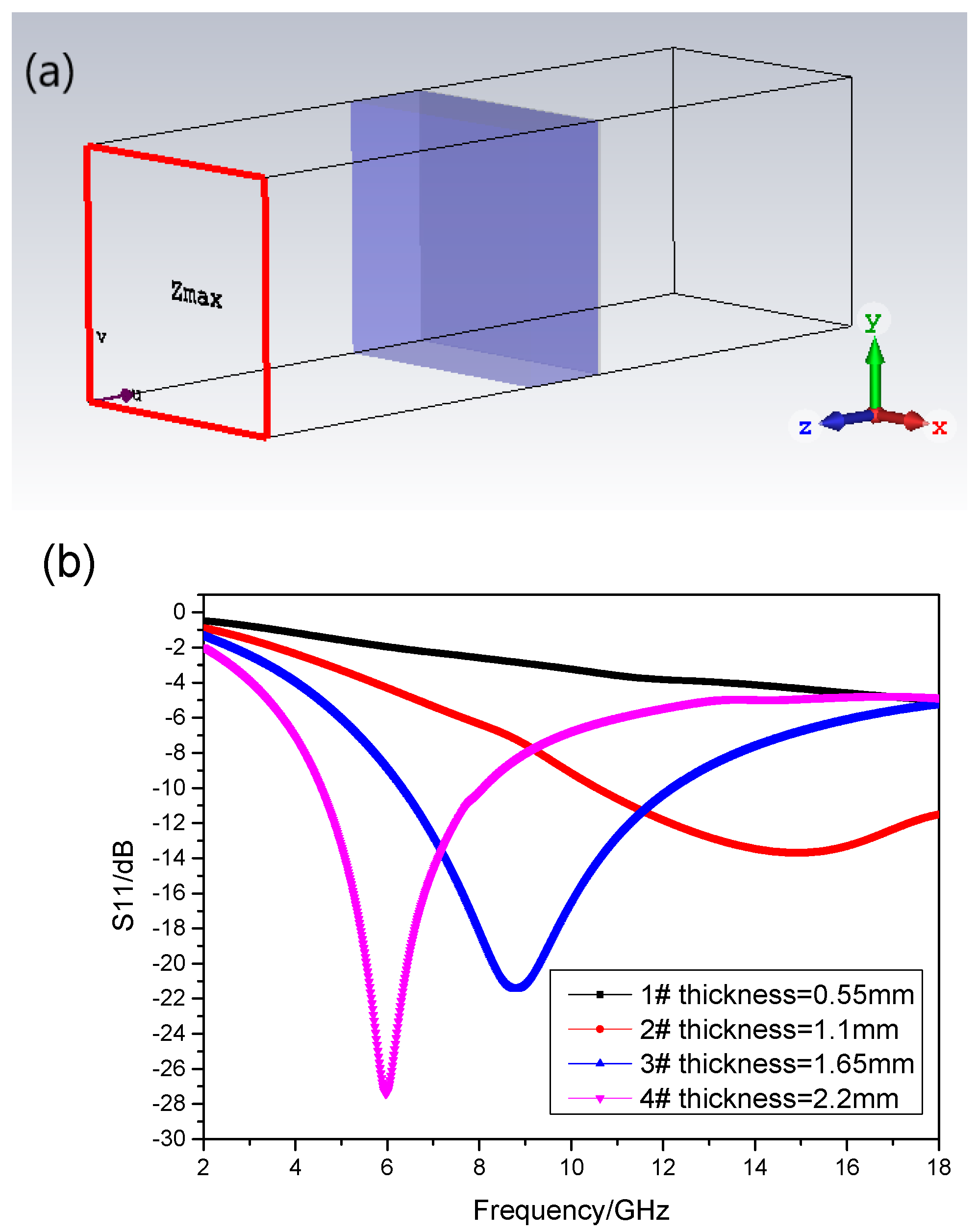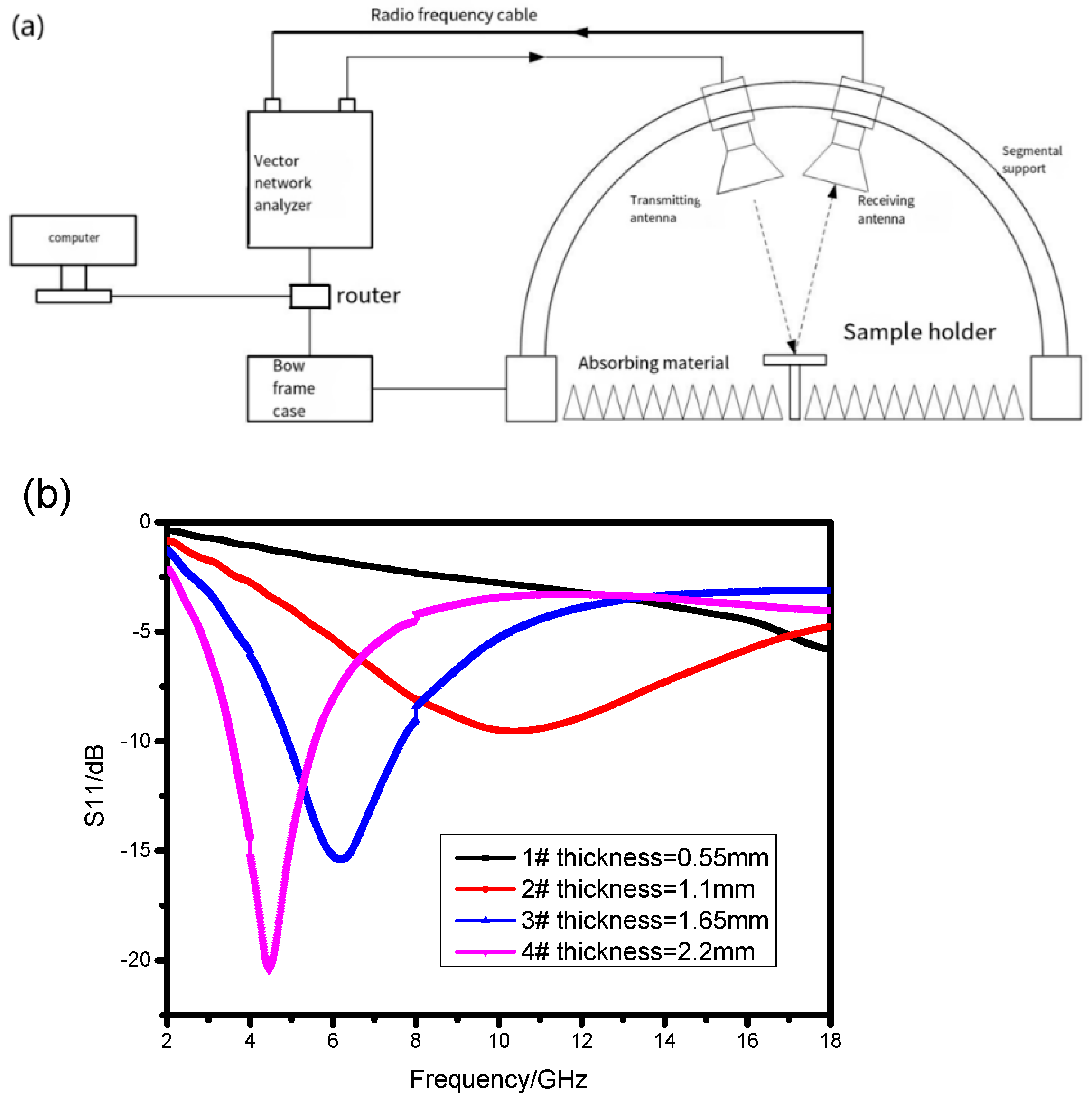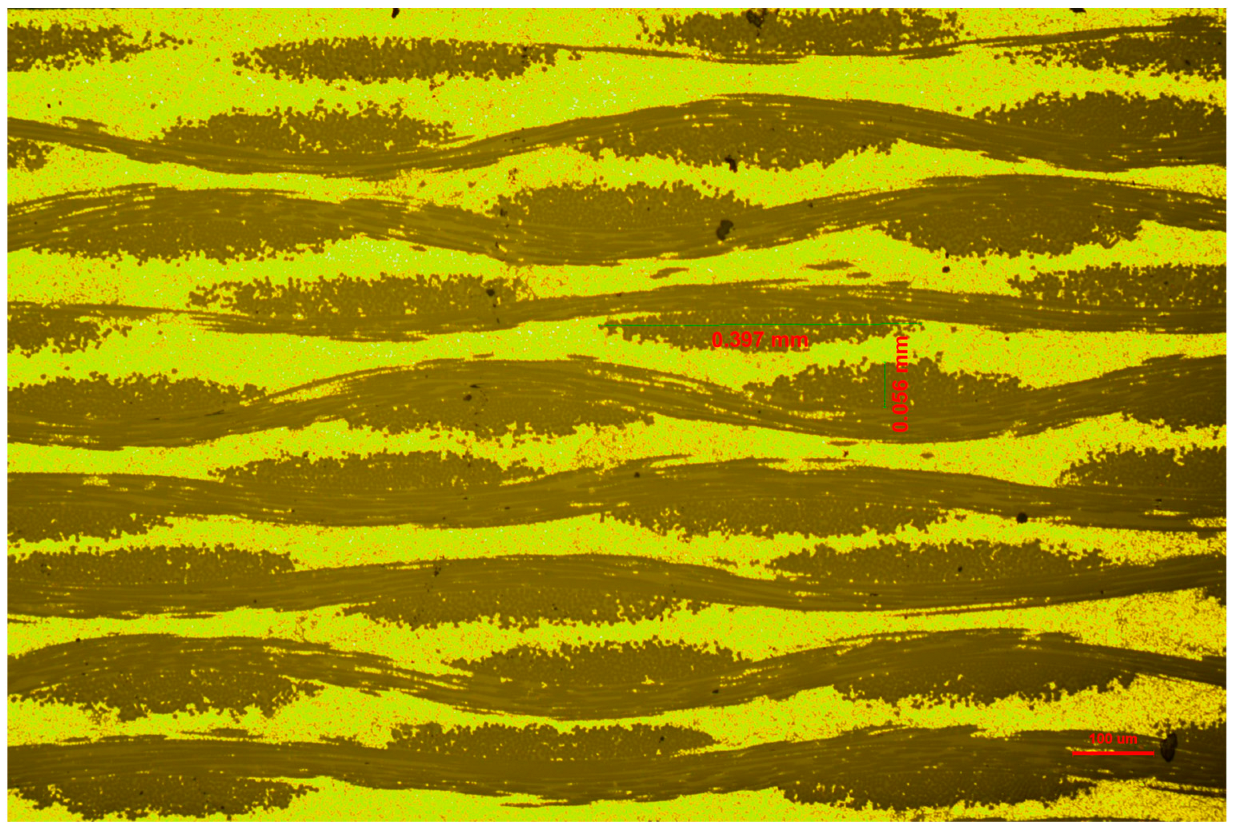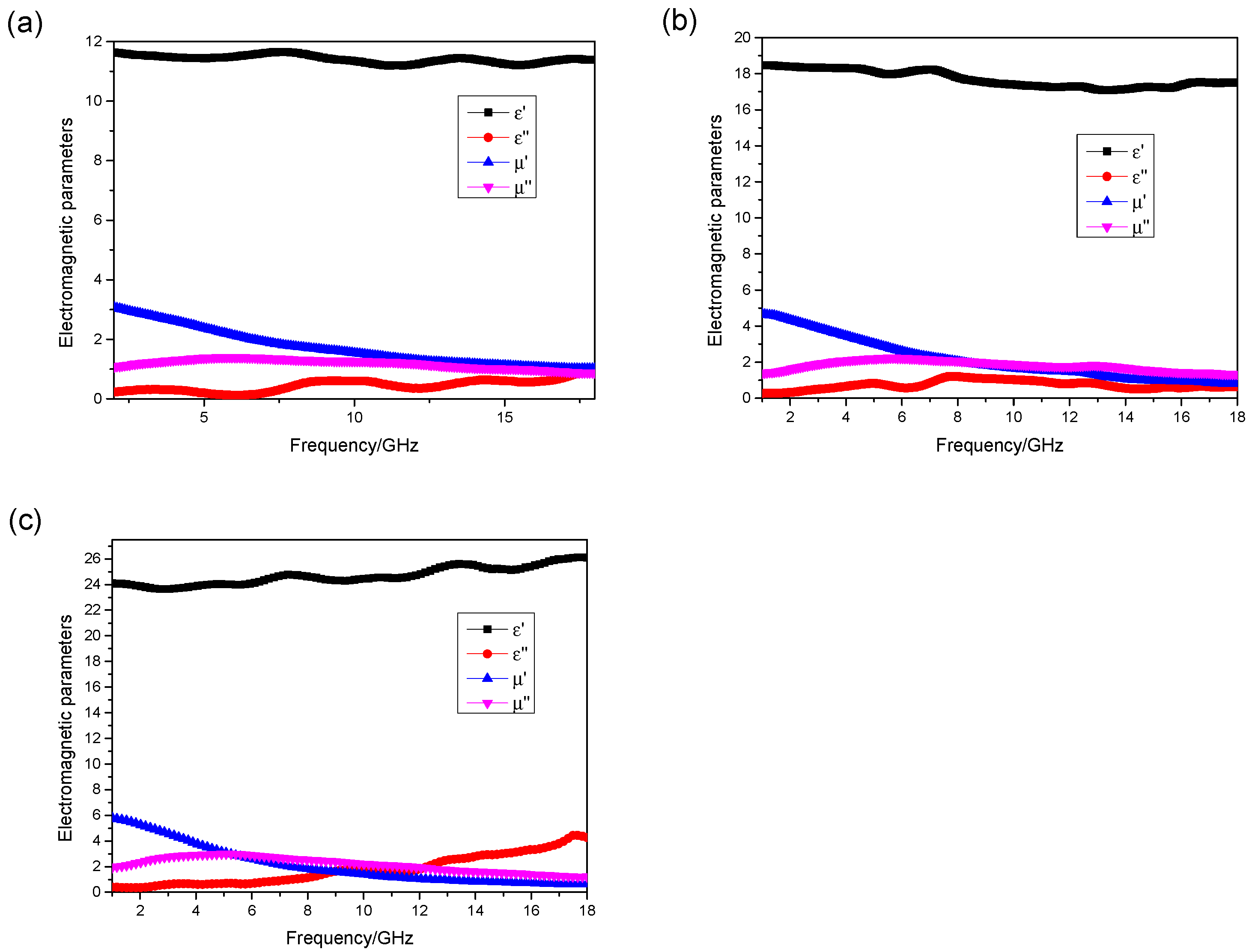Study on Properties of Glass-Fiber-Fabric-Reinforced Microwave-Absorbing Composites
Abstract
:1. Introduction
2. Experimental Section
2.1. Materials
2.2. Preparation of Absorbent/Epoxy Resin Composites
2.3. Preparation of Prepreg
2.4. Preparation of Composite Laminates
3. Results and Discussion
3.1. The Simulation Results of the Composite
3.2. The Experiment Results of the Composite
3.3. The Shape Approximation Methods
4. Conclusions
Author Contributions
Funding
Data Availability Statement
Conflicts of Interest
References
- Xu, X.; Shi, S.; Tang, Y.; Wang, G.; Zhou, M.; Zhao, G.; Zhou, X.; Lin, S.; Meng, F. Growth of NiAl-Layered Double Hydroxide on Graphene toward Excellent Anticorrosive Microwave Absorption Application. Adv. Sci. 2021, 8, 2002658. [Google Scholar] [CrossRef]
- Li, H.; Feng, Y.; Wu, J.; Nie, Z.; Hu, X.; Su, J.; Zan, S.; Zhang, W.; Qi, S.; Wang, R. Preparation of carbon fibers@NiS/Ni3S4@MoS2 with core-sheath structure for high efficiency and wide-bandwidth microwave absorption. Ceram. Int. 2022, 48, 33280–33287. [Google Scholar] [CrossRef]
- Yoo, J.E.; Kang, Y.M. Electromagnetic wave absorbing properties of Ni-Zn ferrite powder-epoxy composites in GHz range. J. Magn. Magn. Mater. 2020, 513, 167075. [Google Scholar] [CrossRef]
- Stanley, J.S.J.; Govind, L.; Mathivathanan, A.; Sindam, B.; James, R.K.C.; Mohandas, M. Impact of reduced graphene oxide on microstructure evolution in m-caproamine/imidazole toughened epoxy composites—Synergia of viscoelastic and microwave absorption properties. Synth. Met. 2022, 286, 117035. [Google Scholar] [CrossRef]
- Kausar, A. Nanocarbon and macrocarbonaceous filler-reinforced epoxy/polyamide: A review. J. Thermoplast. Compos. Mater. 2022, 35, 2620–2640. [Google Scholar] [CrossRef]
- Pratap, V.; Soni, A.; Abbas, S.; Siddiqui, A.; Prasad, N.E. Effect of zinc substitution on U-type barium hexaferrite-epoxy composites as designed for microwave absorbing applications. J. Alloys Compd. 2021, 865, 158280. [Google Scholar] [CrossRef]
- Sun, T.; Liu, Z.; Li, S.; Liu, H.; Chen, F.; Wang, K.; Zhao, Y. Effective improvement on microwave absorbing performance of epoxy resin-based composites with 3D MXene foam prepared by one-step impregnation method. Compos. Part A-Appl. Sci. Manuf. 2021, 150, 106594. [Google Scholar] [CrossRef]
- Rosdi, N.; Azis, R.S.; Ismail, I.; Mokhtar, N.; Zulkimi, M.M.M.; Mustaffa, M.S. Structural, microstructural, magnetic and electromagnetic absorption properties of spiraled multiwalled carbon nanotubes/barium hexaferrite (MWCNTs/BaFe12O19) hybrid. Sci. Rep. 2021, 11, 1–14. [Google Scholar] [CrossRef] [PubMed]
- Naeem, M.; Kuan, H.-C.; Michelmore, A.; Yu, S.; Mouritz, A.P.; Chelliah, S.S.; Ma, J. Epoxy/graphene nanocomposites prepared by in-situ microwaving. Carbon 2021, 177, 271–281. [Google Scholar] [CrossRef]
- Pang, Y.; Li, Y.; Wang, J.; Yan, M.; Chen, H.; Sun, L.; Xu, Z.; Qu, S. Carbon fiber assisted glass fabric composite materials for broadband radar cross section reduction. Compos. Sci. Technol. 2018, 158, 19–25. [Google Scholar] [CrossRef]
- Wen, K.; Liu, Y.; Huang, S.; Su, X.; Liang, C.; Zhao, G. Achieving broadband microwave absorption and excellent mechanical properties via constructing 3D reduced graphene oxide networks in glass fiber/epoxy resin composites. Compos. Sci. Technol. 2022, 229, 109666. [Google Scholar] [CrossRef]
- Lee, S.-E.; Lee, W.-J.; Oh, K.-S.; Kim, C.-G. Broadband all fiber-reinforced composite radar absorbing structure integrated by inductive frequency selective carbon fiber fabric and carbon-nanotube-loaded glass fabrics. Carbon 2016, 107, 564–572. [Google Scholar] [CrossRef]
- Rojas, J.A.; Ribeiro, B.; Rezende, M.C. Influence of serrated edge and rectangular strips of MWCNT buckypaper on the electromagnetic properties of glass fiber/epoxy resin composites. Carbon 2020, 160, 317–327. [Google Scholar]
- Huang, Y.; Yuan, X.; Chen, M.; Song, W.-L.; Chen, J.; Fan, Q.; Tang, L.; Fang, D. Ultrathin multifunctional carbon/glass fiber reinforced lossy lattice metastructure for integrated design of broadband microwave absorption and effective load bearing. Carbon 2019, 144, 449–456. [Google Scholar] [CrossRef]
- Chen, W.; Peng, K.; Wang, J.; He, X.; Su, Y.; Zhang, B.; Su, X. Enhanced microwave absorption properties of nickel-coated carbon fiber/glass fiber hybrid epoxy composites-towards an industrial reality. Mater. Res. Express 2019, 6, 126324. [Google Scholar] [CrossRef]
- Jelmy, E.J.; Lakshmanan, M.; Kothurkar, N.K. Microwave absorbing behavior of glass fiber reinforced MWCNT-PANi/epoxy composite laminates. Mater. Today-Proc. 2020, 26, 36–43. [Google Scholar]
- Mahdikhah, V.; Ataie, A.; Babaei, A.; Sheibani, S.; Ow-Yang, C.W.; Abkenar, S.K. CoFe2O4/Fe magnetic nanocomposite: Exchange coupling behavior and microwave absorbing property. Ceram. Int. 2020, 46, 17903–17916. [Google Scholar] [CrossRef]
- Ribeiro, B.; Gomes, N.A.S.; Rezende, M.C. Lightweight multi-walled carbon nanotube buckypaper/glass fiber-epoxy composites for strong electromagnetic interference shielding and efficient microwave absorption. J. Mater. Sci.-Mater. Electron. 2021, 32, 14494–14508. [Google Scholar] [CrossRef]
- Nam, Y.-W.; Choi, J.-H.; Lee, W.-J.; Kim, C.-G. Fabrication of a thin and lightweight microwave absorber containing Ni-coated glass fibers by electroless plating. Compos. Sci. Technol. 2017, 145, 165–172. [Google Scholar] [CrossRef]
- Silva, A.A.; Stein, R.; Campos, D.; Indrusiak, T.; Soares, B.G.; Barra, G.M.O. Conducting Materials Based on Epoxy/Graphene Nanoplatelet Composites with Microwave Absorbing Properties: Effect of the Processing Conditions and Ionic Liquid. Front. Mater. 2019, 6, 156. [Google Scholar] [CrossRef]
- Dong, J.; Zhou, W.; Gao, L.; Luo, F.; Zhu, D. Effect of curing pressure on mechanical, dielectric and microwave absorption properties of carbon black (CB)-incorporated quartz glass fiber-reinforced polyimide composites. Appl. Phys. A-Mater. Sci. Process. 2018, 124, 693. [Google Scholar] [CrossRef]
- Mohamadi, M.; Kowsari, E.; Haddadi-Asl, V.; Yousefzadeh, M.; Chinnappan, A.; Ramakrishna, S. Highly-efficient microwave absorptivity in reduced graphene oxide modified with PTA@ imidazolium based dicationic ionic liquid and fluorine atom. Compos. Sci. Technol. 2020, 188, 107960. [Google Scholar] [CrossRef]
- Rizzo, A.; Luhrs, C.; Earp, B.; Grbovic, D. CNT Conductive Epoxy Composite Metamaterials: Design, Fabrication, and Characterization. Materials 2020, 13, 4749. [Google Scholar] [CrossRef] [PubMed]
- Akinay, Y.; Çolak, B.; Turan, M.E.; Akkuş, I.N.; Kazici, H.Ç.; Kizilçay, A.O. The electromagnetic wave absorption properties of woven glass fiber composites filled with Sb2O3 and SnO2 nanoparticles doped mica pigments. Polym. Compos. 2022, 43, 8784–8794. [Google Scholar] [CrossRef]
- Rusly, S.N.A.; Ismail, I.; Matori, K.A.; Abbas, Z.; Shaari, A.H.; Awang, Z.; Ibrahim, I.R.; Idris, F.M.; Zaid, M.H.M.; Mahmood, M.K.A.; et al. Influence of different BFO filler content on microwave absorption performances in BiFeO3/epoxy resin composites. Ceram. Int. 2020, 46, 737–746. [Google Scholar] [CrossRef]
- Pratap, V.; Singh, B.; Kumar, S.; Soni, A.K.; Katiyar, M.; Agarawal, K.; Sharma, Y.K.; Siddiqui, A.M.; Abbas, S.M.; Prasad, N.E. Electromagnetic and Microwave Absorbing Properties of U-type Barium Hexaferrite/Polyaniline-Epoxy Composites. In Proceedings of the 3rd International Conference on Condensed Matter & Applied Physics (ICC-2019), Bikaner, India, 14–15 October 2020. [Google Scholar]
- da Silva, L.V.; Pezzin, S.; Rezende, M.C.; Amico, S.C. Glass Fiber/Carbon Nanotubes/Epoxy Three-Component Composites as Radar Absorbing Materials. Polym. Compos. 2016, 37, 2277–2284. [Google Scholar] [CrossRef]
- Thi, Q.V.; Tung, N.T.; Sohn, D. Attenuation of electromagnetic microwaves by a sandwich-like hybrid nanocomposite of reduced graphene oxide and amine-functionalized magnetic mesoporous silica. Synth. Met. 2019, 254, 68–74. [Google Scholar] [CrossRef]
- Zheng, X.L.; Zhu, Z.H.; Li, X.M. The absorbing properties of Fe73.5Cu1Nb3Si13.5B9 amorphous powder/S-glass fiber-reinforced epoxy composite panels. Rare Met. 2013, 32, 294–298. [Google Scholar] [CrossRef]
- Chen, W.; Zhen, B.; Xie, Y.; He, X.; Su, Y.; Wang, J.; Wu, Y. Microwave Absorption and Mechanical Properties of Short-cutted Carbon Fiber/glass Fiber Hybrid Veil Reinforced Epoxy Composites. J. Wuhan Univ. Technol.-Mater. Sci. Ed. 2023, 38, 248–254. [Google Scholar] [CrossRef]
- Chen, W.; Zheng, X.; He, X.; Su, Y.; Wang, J.; Yang, J.; Chen, S.; Zheng, Z. Achieving full effective microwave absorption in X band by double-layered design of glass fiber epoxy composites containing MWCNTs and Fe3O4 NPs. Polym. Test. 2020, 86, 106448. [Google Scholar] [CrossRef]
- Liu, Y.; He, D.; Dubrunfaut, O.; Zhang, A.; Pichon, L.; Bai, J. Hybrids of glass fibers coated with carbon nanotubes and nickel for high-performance electromagnetic wave absorption composites. J. Appl. Polym. Sci. 2022, 139, 51727. [Google Scholar] [CrossRef]
- Zhao, R.; Xia, J.; Adamaquaye, P.; Zhao, G. High density interfaces enhanced microwave absorption in multifunctional carbon nanotubes-glass fiber-epoxy composites. Polym. Adv. Technol. 2022, 33, 818–830. [Google Scholar] [CrossRef]
- Talebi, H.; Olad, A.; Nosrati, R. Fe3O4/PANI nanocomposite core-shell structure in epoxy resin matrix for the application as electromagnetic waves absorber. Prog. Org. Coat. 2022, 163, 106665. [Google Scholar] [CrossRef]
- Nagasree, P.S.; Ramji, K.; Naidu, M.K.; Shami, T.C. X-band radar-absorbing structures based on MWCNTs/NiZn ferrite nanocomposites. Plast. Rubber Compos. 2021, 50, 71–82. [Google Scholar] [CrossRef]
- Haritha, T.; Ramji, K.; Subrahmanyam, C.; Krushnamurthy, K.; Nagasree, P.S. Microwave-absorption characteristics of polyaniline-coated multi-walled carbon nanotube composites. Plast. Rubber Compos. 2021, 50, 180–188. [Google Scholar] [CrossRef]
- Wang, S.J.; Zhang, W.; Zhao, Y. Preparation and Microwave Absorption properties of Glass beads/Carbon Fiber with Electro less Ni-Plating. Adv. Mater. Res. 2012, 476–478, 1125–1129. [Google Scholar] [CrossRef]










| Sample | Label | Ply Count | Lay-Up | Thickness | Lamina Thickness |
|---|---|---|---|---|---|
| 1# | E1 | 5 | [0]5 | 0.55 mm | 0.11 mm |
| 2# | E1 | 10 | [0]10 | 1.10 mm | 0.11 mm |
| 3# | E1 | 15 | [0]15 | 1.65 mm | 0.11 mm |
| 4# | E1 | 20 | [0]20 | 2.20 mm | 0.11 mm |
| Sample | Absorbing Peak | Bandwidth of RL ≤ −10 dB | |||
|---|---|---|---|---|---|
| Simulation | Experiment | Error | Simulation | Experiment | |
| 2# | 14.91 | 10.35 | 4.56 | 10.56~18 | / |
| 3# | 8.80 | 6.19 | 2.61 | 6.35~12.20 | 4.93~7.63 |
| 4# | 5.79 | 4.46 | 1.33 | 4.56~8.10 | 3.56~5.58 |
| Approximation Shape | The Mass Ratio |
|---|---|
| Parallelogram | 80.07% |
| Combination of two bows | 85.95% |
| Ellipse | 90.49% |
| Sample | Experiment | Parallelogram | Combination of Two Bows | Ellipse | |||
|---|---|---|---|---|---|---|---|
| / | Error | / | Error | / | Error | ||
| 2# | 10.35 | 13.23 | 2.88 | 9.23 | 1.12 | 5.95 | 4.4 |
| 3# | 6.19 | 7.98 | 1.79 | 5.63 | 0.56 | 4.03 | 2.16 |
| 4# | 4.46 | 5.55 | 1.09 | 4.05 | 0.41 | 2.93 | 1.53 |
| Sample | Combination of Two Bows | Experiment |
|---|---|---|
| 2# | 7.14~11.65 | / |
| 3# | 4.29~7.58 | 4.93~7.63 |
| 4# | 3.20~5.20 | 3.56~5.58 |
Disclaimer/Publisher’s Note: The statements, opinions and data contained in all publications are solely those of the individual author(s) and contributor(s) and not of MDPI and/or the editor(s). MDPI and/or the editor(s) disclaim responsibility for any injury to people or property resulting from any ideas, methods, instructions or products referred to in the content. |
© 2024 by the authors. Licensee MDPI, Basel, Switzerland. This article is an open access article distributed under the terms and conditions of the Creative Commons Attribution (CC BY) license (https://creativecommons.org/licenses/by/4.0/).
Share and Cite
Zhou, Z.; Liu, Y.; Chen, X.; Wang, Z.; Zhao, Y. Study on Properties of Glass-Fiber-Fabric-Reinforced Microwave-Absorbing Composites. Materials 2024, 17, 1453. https://doi.org/10.3390/ma17071453
Zhou Z, Liu Y, Chen X, Wang Z, Zhao Y. Study on Properties of Glass-Fiber-Fabric-Reinforced Microwave-Absorbing Composites. Materials. 2024; 17(7):1453. https://doi.org/10.3390/ma17071453
Chicago/Turabian StyleZhou, Zhuohui, Yang Liu, Xi Chen, Zhiyong Wang, and Yan Zhao. 2024. "Study on Properties of Glass-Fiber-Fabric-Reinforced Microwave-Absorbing Composites" Materials 17, no. 7: 1453. https://doi.org/10.3390/ma17071453






